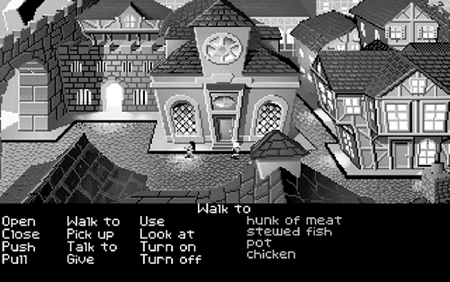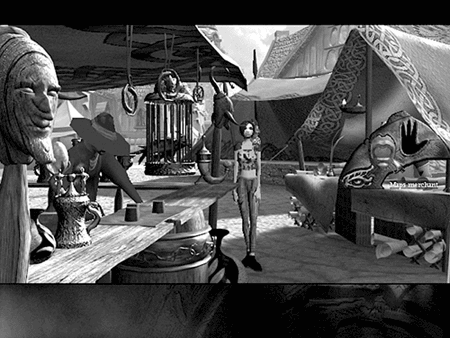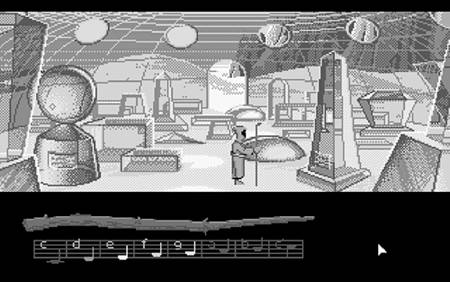User Interface Design
User Interface DesignAdventure games, more than most other genres, try to hide the fact that the player is using a computer. By comparison to vehicle simulators, sports games, or RPGs, the user interfaces of adventure games are very simple. The player needs to move through the world, talk to NPCs, and manipulate or collect objects in an intuitive way that does not interfere with his sense of immersion in the story. Avatar MovementThe movement interface that you design depends considerably on the perspective you choose. In first-person and third-person perspectives, the player needs a way of steering her avatar around the world, as in an action game. We suggest that you look at Chapter 9, "Action Games," for a discussion of avatar movement in first- and third-person perspectives. In a context-sensitive perspective, there are two common user interfaces: point-and-click and direct control . Point-and-Click InterfacesIn this user interface, the player clicks somewhere on the screen. If the corresponding location in the game is accessible, the avatar walks to it. If the player clicks an active object, the avatar walks to it and picks it up or manipulates it in an appropriate way. Object management is discussed more extensively in the "Manipulating Objects" section later in this chapter. The disadvantage of point-and-click is that the player can easily point to areas that aren't accessible to the avatar (halfway up a wall, for example), and sometimes an area that looks as if it should be perfectly accessible isn't. This can be frustrating for the player. Nevertheless, the point-and-click interface is the de facto standard for adventure games. Direct Control InterfacesIn a direct control user interface, the player's commands say "Walk in this direction" rather than "Walk to this point," as they do in a point-and-click interface. In these kinds of games, such as Grim Fandango , from LucasArts, the player "steers" the avatar around the screen. Direct control can be awkward in a context-sensitive perspective because the camera angle changes from scene to scene. Movement SpeedNo matter what perspective or user interface you choose, we strongly suggest that you implement both a "walk" and a "run" movement mode so the player can move slowly through unfamiliar spaces and quickly through familiar ones. If the game requires the player to move repeatedly through areas he already knows well, it gets very boring to watch the avatar walk deliberately from place to place. On the other hand, if your world is rich and detailed and your game expects the player to examine everything closely for clues, the user interface must make it possible to move around slowly and accurately. Manipulating ObjectsOne of the great challenges in designing an adventure game is in determining how the player should manipulate objects in the world. In many games, the player must figure out what to do with particular objects to solve puzzles and advance the game. In text adventures , this amounted to guessing the correct verb. You often got interchanges that looked like this: > OPEN DOOR The door is locked, but it looks pretty flimsy. > BREAK DOOR I don't know how to do that. > SMASH DOOR I don't know how to do that. > HIT DOOR I don't know how to do that. > KICK DOOR The door flies open. Sometimes this was fun; a lot of the time it wasn't. In graphic adventure games, in which the player is using the mouse or a handheld controller, designers can solve this problem in a variety of different ways. Identifying Active ObjectsNot every object in the game world can be manipulated or picked up; some are just part of the background scenery . The player needs a way of recognizing the active objects in a particular location. Text adventures used to print a list of them. Graphic adventures have typically used one of four mechanisms:
One-Button ActionsIn a graphic adventure game played with a handheld controller, designers often assign one button of the controller to a generic "use" or "manipulate" function: The player moves the avatar near the object and presses the "use" button for obvious functions such as opening a door or throwing a switch. The player can always count on the button to do the right thing with an object, whatever that might be. Some mouse-based games use a similar mechanism: Clicking an object does something appropriate with it. This makes the game very easy to play because there's no guessing about what you should do. The disadvantage of this system is that there can be only one action per object, so it doesn't allow the designer to challenge the player's lateral thinking. Menu-Driven ActionsA number of games use a menu to allow the player to select the action he wants to take and the object that he wants to manipulate (see Figure 15.9). This gives the player a clear picture of his choices, but it does feel a little "computery." Figure 15.9. The action menu in The Secret of Monkey Island . In another variant, the player places the mouse cursor over the desired object and right-clicks it. A pop-up menu appears, showing a series of icons that represent the actions "take," "use," "examine," and possibly others (see Figure 15.10). The player left-clicks one of the icons, and the desired action is performed. This mechanism, in effect, shows the player all the available verbs that can be used with that particular object and lets him pick one. Figure 15.10. The pop-up menu in The Longest Journey (at right, under tent). Note that the icons are an eye, a mouth, and a hand, meaning "look at," "talk to," and "manipulate." Managing InventoryPicking things up and carrying them around until they're needed later has been a major feature of adventure gaming since its beginning. Most games implement a limit on the amount of stuff the player can carry. (However, a few did not, for humorous effect: In Haunt , a noncommercial text adventure, the player could be walking through a haunted house wearing a wetsuit and carrying around a stereo, an antique chair , and an oil painting, along with an unlimited number of other items.) With the arrival of graphics, the inventory is usually handled as a pop-up box that shows everything the player is carrying whenever she asks to see it. If the box has a fixed size on the screen, it creates a natural limit on the amount a player can carry. When the box is full, she can't put anything else in it unless she takes something out first. Inventory management is something the player will need to do frequently, so you should make it as easy as possible. One possibility is to devote a part of the screen to the inventory all the time. This is very easy to work with, although it tends to remind the player that he's using a computer. Its biggest disadvantage is that, unless you sacrifice a lot of screen area or implement a scrollbar, it can't be very big. The more common solution is to give the player an inventory menu that she can open and close on demand. She should be able to do this with a single keystroke or button click. It should not obscure the whole screen ”that feels like a mode change and tends to destroy suspension of disbelief. Instead, the box, bag, or whatever the inventory looks like should allow the player to drag objects in and out of it, from the game world to the inventory, and vice versa, quickly and efficiently . The Longest Journey included shortcut keys that allowed players to change the object currently being held in the avatar's hand without opening the inventory box, which was very convenient. Managing the inventory this way also means that you won't have to create animations of the avatar picking up and dropping every possible item in the game. Asheron's Call , an online RPG, includes "pick up" and "drop" animations, but they don't actually show the object in the avatar's hand. One design error to avoid in adventure games is requiring the player to pick up every thing she sees. Early adventure games listed the "live" objects in a room separately from the room's description, and there was a common tendency to give every object in a game a particular function. This meant that players had to pick up everything they could, often carrying it around for hours without having any idea what it was for. With the advent of 3D- modeled objects, everything in the whole world is (theoretically) available for the player to pick up. The inventory is a typical feature of adventure games, but it is not absolutely required. One game, in particular ”the LucasArts adventure Loom ”was designed without an inventory. The player performed all actions in the game by "spinning" musical spells on a distaff, which was the only thing he carried (see Figure 15.11). Loom was designed to be especially accessible to people who were not already familiar with adventure games. Although it was short and considered by die-hard adventurers to be too easy, it was one of the most imaginative and beautifully executed adventure games ever created. Figure 15.11. Loom . Note the musical distaff at the bottom of the screen, used for all actions other than movement. |
EAN: 2147483647
Pages: 148


